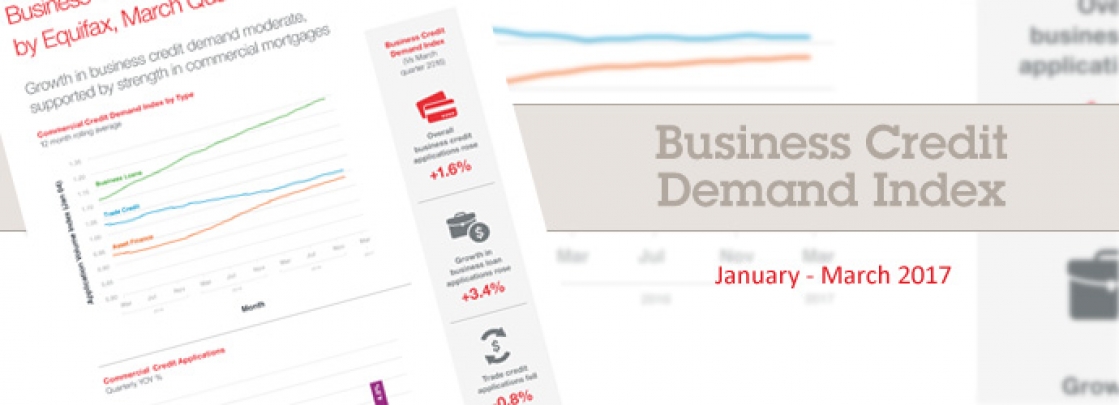Growth in business credit demand moderate, supported by strength in commercial mortgages

Business Credit Demand Index by Equifax (March 2017 Quarter)
- Overall business credit applications rose +1.6% (vs March quarter 2016)
- Growth in business loan and asset finance applications rose, while trade credit applications fell (vs March quarter 2016)
- Growth in commercial mortgage applications increased +25.7% (vs March quarter 2016)
Sydney, Australia, Thursday, 20 April 2017 – The Quarterly Business Credit Demand Index by Equifax, which measures the level of business loan, trade credit, and asset finance applications, rose at an annual rate of 1.6% in the March quarter, compared to the same period last year.
Released today by Equifax, the global information solutions company and the leading provider of credit information and analysis in Australia and New Zealand, the Index results reflected an increase of +3.4% in business loan applications, and +1.8% in asset finance applications, compared to the same period in 2016. However, the overall growth rate was tempered by a fall of -0.8% in trade credit applications.
The growth in business loan applications was supported by a significant strengthening in commercial mortgage applications, which rose 25.7% year-on-year.
Neil Shilbury, General Manager, Commercial and Property Products at Equifax, said the moderate growth in the Index indicated a steady outlook for businesses.
“The rate of growth in the March quarter is reflective of Australia’s broader economic situation. While there are a number of factors supporting economic growth – stronger commodity prices off the back of fiscal improvement in China, and the completion of mining projects commenced during the resources boom which are now resulting in increased exports – the negative impact of falling mining investment still lingers,” Mr Shilbury said.
“Much of the growth seen in the March Index can be attributed to commercial mortgage demand. This activity is driven in large part by the fact that interest rates remain at record lows, encouraging the investment housing boom to continue, despite regulators’ attempts to cool the market,” he continued.
While growth in the number of applications for business credit eased in both the mining and non-mining jurisdictions in the March quarter, stronger conditions continue to be seen in the non-mining jurisdictions (+2.8%) than in the mining jurisdictions (-1.0%) of Queensland, Western Australia, and the Northern Territory. That said, Queensland is showing early signs of growth (+0.9%), benefitting from broader economic activity, such as housing investment and tourism.
“According to the Reserve Bank of Australia’s assessment, Australia is now 90% of the way back to normal levels of business investment from the peak in mining investment in 2012,” Mr Shilbury said.
“While businesses may take comfort in the knowledge that much of the pain has passed, there are still likely to be some challenges for the Australian economy in the short term. The easing in the growth of the March quarter Index reflects those challenges,” he added.
The pace of growth in overall business credit applications eased in the March quarter. Demand for business credit was strongest in the ACT (+4.9%), followed by Victoria (+3.8%), NSW (+2.7%), and Queensland (+0.9%). SA (-1.0%), Tasmania (-2.7%), the NT (-4.6%), and WA (-4.8%) all experienced declines in business credit demand.
Growth in business loan applications eased slightly, but remained solid in the March quarter (+3.4%). Of the non-mining jurisdictions, NSW (+8.4%), the ACT (+7.8%) and Victoria (+4.5%) all saw positive growth in business loan applications, while SA (-0.2%) and Tasmania (-6.1%) experienced falls. Across the mining jurisdictions, Queensland (-1.6%), WA (-3.4%), and the NT (-13.7%) all declined.
Within business loans, mortgage applications (+25.7%) have continued to strengthen, and have now surpassed the strong annual rates of growth recorded in the June quarter of 2015. Growth in lending proposals (+7.9%) also remained strong in the March quarter, but credit cards (-29.3%), overdrafts (-18.7%), and premium finance (-33.0%) all fell.
Trade credit applications declined in the March quarter (-0.8%). The growth in trade credit applications was strongest in Victoria (+1.7%), Queensland (+1.6%), the ACT (+0.7%), and the NT (+0.5%), while NSW (-1.7%), SA (-1.7%), Tasmania (-4.9%), and WA (-6.9%) all recorded falls.
Growth in asset finance applications eased in the March quarter (+1.8%). In the non-mining jurisdictions, growth in asset finance applications was strongest in the ACT (+5.7%) and Tasmania (+5.6%). Asset finance applications also remained positive in Victoria (+4.9%), while NSW was flat and SA (-1.2%) experienced a fall. Across the mining jurisdictions, growth in asset finance applications was stronger in Queensland (+3.6%), and the NT (+1.9%), while WA (-3.6%) continued to decline.
There were differentiated movements within asset finance account types. Applications for commercial rental (+12.7%) continued to show strength, as did leasing (+9.0%) and auto loans (+7.2%). In contrast, applications for hire purchase (-13.0%) and bill of sale (-4.2%) both showed a fall.
NOTE TO EDITORS
The Quarterly Business Credit Demand Index by Equifax Index measures the volume of credit applications that go through the Commercial Bureau by credit providers such as financial institutions and major corporations in Australia. Based on this it is a good measure of intentions to acquire credit by businesses. This differs to other market measures published by the RBA/ABS, which measure new and cumulative dollar amounts that are actually approved by financial institutions.
DISCLAIMER
Purpose of media releases from Equifax: The information in this release is general in nature, is not intended to provide guidance or commentary as to the financial position of Equifax and does not constitute legal, accounting or other financial advice. To the extent permitted by law, Equifax provides no representations, undertakings or warranties concerning the accuracy, completeness or up-to-date nature of the information provided, and specifically excludes all liability or responsibility for any loss or damage arising out of reliance on information in this release including any consequential or indirect loss, loss of profit, loss of revenue or loss of business opportunity.
